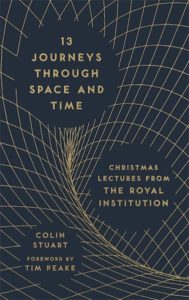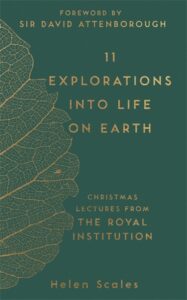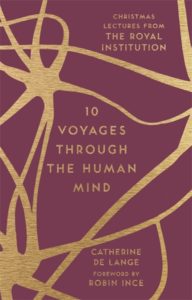Since their inauguration by Michael Faraday in 1825, the Christmas Lectures of the Royal Institution have been presented annually with only a break from 1939 to 1942. The purpose of the lectures is simple: to present discoveries in the various fields of science to popular audience, adults and children alike, in manner that is engaging as well as entertaining. Not surprisingly, they are wildly popular, with tickets for admission to their in-person delivery being “allocated via a ballot which opens in September and is available to Ri Patrons, Ri Members, Ri Young Members and UK registered schools in September of that year.” Fortunately for all those within the BBC’s broadcast range, they are also broadcast on BBC Four and for the rest of us, recent lecture series have been uploaded to the Ri’s YouTube channel.
Beginning in 2016, Michael O’Mara Books, in partnership with the Ri began publishing what has now risen to a total of three volumes of collected, well-crafted summaries of some of the most notable of the Christmas Lectures with each volume taking a particular subject area as it’s theme.
 The first volume, 13 Journeys Through Space and Time, is written by Colin Stuart, with a forward by Maj. Tim Peake. Taking the exploration of space, and more recently that of time as well, as its central theme, this volume begins with Sir Robert Stawell Ball’s 1881 lecture series “The Sun, the Moon, and the Planets” and concludes with Dr. Kevin Fong‘s “How to Survive in Space” from 2015. It also includes such noteworthy addresses as Sir Herbert Hall Turner’s “A Voyage in Space from 1913, Dr. Carl Sagan’s “The Planets” from 1977, and Dr. Frank Close‘s 1993 “The Cosmic Onion.”
The first volume, 13 Journeys Through Space and Time, is written by Colin Stuart, with a forward by Maj. Tim Peake. Taking the exploration of space, and more recently that of time as well, as its central theme, this volume begins with Sir Robert Stawell Ball’s 1881 lecture series “The Sun, the Moon, and the Planets” and concludes with Dr. Kevin Fong‘s “How to Survive in Space” from 2015. It also includes such noteworthy addresses as Sir Herbert Hall Turner’s “A Voyage in Space from 1913, Dr. Carl Sagan’s “The Planets” from 1977, and Dr. Frank Close‘s 1993 “The Cosmic Onion.”
 2017 saw the publication of a second volume: 11 Explorations into Life on Earth. Written by Dr. Helen Scales and featuring a foreword by Sir David himself, this volume takes readers through the realms of biology. Bracketed by Sir Peter Chalmers Mitchell’s 1913 “The Childhood of Animals” and Dr. Sue Hartley‘s 2009 “The 300-million-year War,” the collection also includes Sir Julian Huxley’s 1937 “Rare Animals and the Disappearance of Wild Life” and Dr. Desmond Morris’ 1964 “Animal Behavior,” and Sir David Attenborough’s own “The Languages of Animals” from 1973. (N.B., This is the volume that first brought then entire series to my attention.)
2017 saw the publication of a second volume: 11 Explorations into Life on Earth. Written by Dr. Helen Scales and featuring a foreword by Sir David himself, this volume takes readers through the realms of biology. Bracketed by Sir Peter Chalmers Mitchell’s 1913 “The Childhood of Animals” and Dr. Sue Hartley‘s 2009 “The 300-million-year War,” the collection also includes Sir Julian Huxley’s 1937 “Rare Animals and the Disappearance of Wild Life” and Dr. Desmond Morris’ 1964 “Animal Behavior,” and Sir David Attenborough’s own “The Languages of Animals” from 1973. (N.B., This is the volume that first brought then entire series to my attention.)
 Most recently, Catherine de Lange‘s presentation of 10 Voyages Through the Human Mind was added as the series’ third volume. With a forward by Robin Ince, this volume takes human brain and its psychology as it’s theme. Unfortunately, I do not possess a copy of this volume, so the specific lecture summaries it includes are unknown to me at this time; hence I can only offer the Ri’s own description of it as “explore[ing] this hidden world though lectures by leading experts in psychology, neurology and biology spanning over 100 years.”
Most recently, Catherine de Lange‘s presentation of 10 Voyages Through the Human Mind was added as the series’ third volume. With a forward by Robin Ince, this volume takes human brain and its psychology as it’s theme. Unfortunately, I do not possess a copy of this volume, so the specific lecture summaries it includes are unknown to me at this time; hence I can only offer the Ri’s own description of it as “explore[ing] this hidden world though lectures by leading experts in psychology, neurology and biology spanning over 100 years.”
The 2019 lectures, already recorded and awaiting broadcast at the time of this writing, feature the brilliant mathematician and science communicator Dr. Hannah Fry presenting “Secrets and Lies; the Hidden Power of Maths.” I will, of course, be eagerly awaiting the uploading of these lectures by the Ri to their YouTube Channel, having been unable to attend them in person (living on the opposite side of the planet, as I do – and not having won a ticket) or being presently unable to view them on BBC Four (the service being blocked outside the UK). However for all those who are able to sit down in front of your telly or computer and view them for yourself, I greatly envy you, and I hope you find them to be the remarkable Christmas Treat that they have been for nearly two hundred years now.
